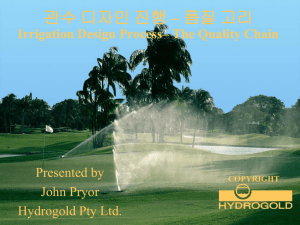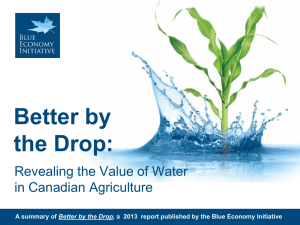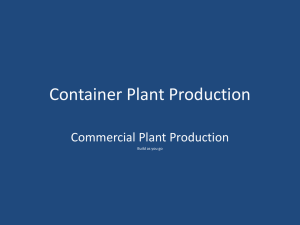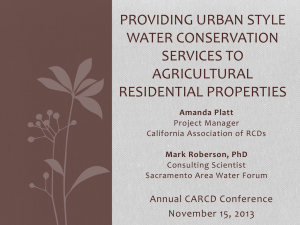Document
advertisement
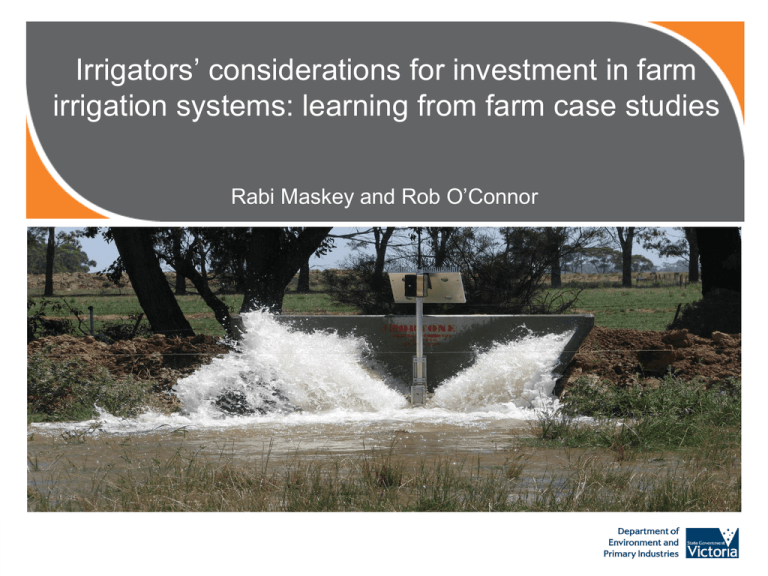
Irrigators’ considerations for investment in farm irrigation systems: learning from farm case studies Rabi Maskey and Rob O’Connor Irrigation delivery system Supply wheel Upgraded/automated main supply channel Plastic lined main supply channel Solar powered control box Farm Water Program – Farm Water Program (also known as On-farm Irrigation Efficiency Program) is about achieving farm water savings through improved farm irrigation – The water savings are shared between farmers and the environment, with at least half the water savings transferred to the State or Commonwealth environmental water holders – Invest over $200 million of government money – Approximately 400 projects been funded Farm Water Program – The program assess the water savings – based on • • • Soil type Types of crop grown Technology to be adopted – Half of the water savings transferred to government For example: • • • Say a landowner saves 100ML Then he/she will receive (eg. $1800/ML X 50ML= $90K) on transfer (90 ML) the balance (eg. up to $1800/ML X 50ML= $90K) after the completion of the work On-farm irrigation systems Centre pivot Pipe and riser Improved border check irrigation Laser grading On-farm irrigation systems Re-use system Linear move system Computerised scheduling system Is the irrigation investment financially viable to my situation? Outline of presentation – Identify whether or not irrigation investments are viable from irrigators’ perspective – Identify the reasons for irrigators’ participation in the Farm Water Program and the learning from it – How the learnings are shared with other irrigators and the broader industry Case Study approach – – – – – 5 case studies Examined ‘without’ and ‘with’ project situations Partial budget analysis & discounted cash flow analysis Project life 20 years 7% real discount rate – Economic criteria used: Net Present Value (NPV) Benefit-Cost Ratio (BCR) Internal Rate of Return (IRR) Period to break-even (years) – Sensitivity analysis Summary of five case studies Case Study 1 Case Study 2 Case Study 3 Case Study 4 Case Study 5 Improved Border- Check Irrigation Automatic Irrigation Improved Border- Check Irrigation Pipes and Risers Centre Pivot Industry Dairy Dairy Cropping Cropping Cropping Project area 24 ha 24 ha 65 ha 109 ha 25 ha Crops ‘without’ project Perennial pasture Perennial pasture Barley and wheat Rye grass and oats Rain-fed wheat Crops ‘with’ project Perennial pasture Perennial pasture Canola, wheat and lucerne rotation Canola, wheat and lucerne rotation Canola and wheat rotation Irrigation technology Project costs Costs (per ha) Irrigation technology Industry Capital cost Annualised capital cost* Improved Border Check Irrigation Automatic Irrigation Improved Border Check Irrigation Pipes and Risers Centre Pivot dairy dairy cropping cropping cropping $2,994 $1,627 $2,700 $3,300 $4,120 $283 $154 $255 $312 $390 - $38 $30 $26 $98*** $52 $66 $82 Annualised other costs** $122 Maintenance cost $60 Notes: *Assumes 20 year life project with 7% discount rate **Once off decommissioning costs, pasture re-establishment costs, removal of lucerne *** Includes yearly licence fee Project benefits Industry Production benefits Water saving benefits Improved Border Check Irrigation Automatic Irrigation dairy dairy cropping cropping cropping 2 t DM/ha/year No productivity benefits High value crop mix; increased production High value crop mix; increased production High value crop mix; increased production 5% of water applied 6ML/irrigation (reduction of leakage in channels) and 20% of the water applied 2.4 ML/ha/year Improved Border Pipes and Risers Check Irrigation 7ML/irrigation (reduction of leakage in channels) and 20% of the water applied Time saving benefits 4 hrs/ irrigation 7.5 hrs/ irrigation 30 hrs/ irrigation 36 hrs/ irrigation Vehicle use benefits - 36km less travelled/irrigation 60km less travelled/ irrigation 70km less travelled/irrigation Government incentives $28,700 $18,500 $81,000 $180,000 Centre Pivot - Targeted water application possible - Irrigation complemented the use of increased fertiliser input to increase productivity. - Pumping cost of $30-$40/ML in addition to the cost of water None Case Study approach – 7% discount rate (opportunity cost of capital) Year 0 1 2 3 4 5…. 20 most costs (now) most benefits some costs bring it to today’s $ (Present value of the investment) Benefit cost analysis with incentive Industry Net Present Value Benefit-Cost Ratio Internal Rate of Return (%) Period to break even Improved Border Check Irrigation Automatic Irrigation Improved Border Check Irrigation Pipes and Risers Centre Pivot dairy dairy cropping cropping cropping +$90,200 +$5,600 +$266,000 +$545,000 1.60 1.09 2.2 2.2 14% 8% 27% 30% 8 years 9 years 5 years 4 years Did not receive incentive Benefit cost analysis without incentive Improved Border Check Irrigation Automatic Irrigation Improved Border Check Irrigation Pipes and Risers Centre Pivot dairy dairy cropping cropping cropping Net Present Value +$62,850 -$11,985 +$185,000 +$365,000 +$29,357 Benefit-Cost Ratio 1.42 0.81 1.8 1.8 1.24 10.5% 0.37% 16.5% 16.5% 10.4% 12 years >20 years 7 years 7 years 12 years Industry Internal Rate of Return (%) Period to break-even Learnings The key benefits from investments are: • Production benefits 2 t DM/ha/year (dairy) high value crop rotation and increased production (cropping); • Water savings ↓ 2.0ML/ha/year (dairy) ↓20% of water application (cropping) • Save time chasing water for both cropping and dairy, i.e. automation of irrigation infrastructure Learnings • Capital costs can range from $1,625 to $4,120 per hectare depending on the type of technologies • Energy costs could be a significant ongoing operating cost for pressurised irrigation systems. For example, the energy cost for a pipe and riser system is likely to be in the range of $7-10/ML and $25-40/ML for a centre pivot system • The Farm Water Program provided funds for irrigators to implement irrigation upgrades quicker than would have been possible without these incentives Learnings • The size of the productivity improvement is the key to the viability of irrigation infrastructure investment • Water savings and labour savings only (without productivity increase) are unlikely to make the irrigation infrastructure investment viable Extending the learnings Farm walks Irrigation Expo Workshop for service providers Publications Thank you.


